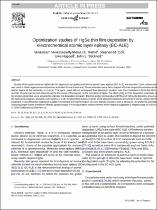 ResearchSpace
ResearchSpace
Optimization studies of HgSe thin film deposition by electrochemical atomic layer epitaxy (EC-ALE)
JavaScript is disabled for your browser. Some features of this site may not work without it.
- ResearchSpace
- →
- Research Publications/Outputs
- →
- Journal Articles
- →
- View Item
| dc.contributor.author |
Venkatasamy, V

|
en_US |
| dc.contributor.author |
Mathe, Mahlanyane K

|
en_US |
| dc.contributor.author |
Cox, SM

|
en_US |
| dc.contributor.author |
Happek, U

|
en_US |
| dc.contributor.author |
Stickney, JL

|
en_US |
| dc.date.accessioned | 2007-01-04T12:04:05Z | en_US |
| dc.date.accessioned | 2007-06-07T10:04:56Z | |
| dc.date.available | 2007-01-04T12:04:05Z | en_US |
| dc.date.available | 2007-06-07T10:04:56Z | |
| dc.date.issued | 2006-06 | en_US |
| dc.identifier.citation | Venkatasamy, V et al. 2006. Optimization studies of HgSe thin film deposition by electrochemical atomic layer epitaxy (EC-ALE). Electrochimica Acta, vol 51(21), pp 4347-4351. | en_US |
| dc.identifier.uri | http://hdl.handle.net/10204/1344 | en_US |
| dc.identifier.uri | http://hdl.handle.net/10204/1344 | |
| dc.description.abstract | Studies of the optimization of HgSe thin film deposition using electrochemical atomic layer epitaxy (EC-ALE) are reported. Cyclic voltammetry was used to obtain approximate deposition potentials for each element. These potentials were then coupled with their respective solutions to deposit atomic layers of the elements, in a cycle. The cycle, used with an automated flow deposition system, was then repeated to form thin films, the number of cycles performed determining the thickness of the deposit. In the formation of HgSe, the effect of Hg and Se deposition potentials, and a Se stripping potential, were adjusted to optimize the deposition program. Electron probe microanalysis (EPMA) of 100 cycle deposits, grown using the optimized program, showed a Se/Hg ratio of 1.08. Ellipsometric measurements of the deposit indicated a thickness of 19 nm, where 35 nm was expected. X-ray diffraction displayed a pattern consistent with the formation of a zinc blended structure, with a strong (1 1 1) preferred orientation. Glancing angle fourier transform infrared spectroscopy (FTIR) absorption measurements of the deposit suggested a negative gap of 0.60 eV. | en_US |
| dc.format.extent | 220576 bytes | en_US |
| dc.format.mimetype | application/pdf | en_US |
| dc.language.iso | en | en_US |
| dc.publisher | Elsevier | en_US |
| dc.rights | Copyright belongs to Elsevier: Science Direct | en_US |
| dc.subject | B1. HgSe | en_US |
| dc.subject | A3. EC-ALE; A3. UPD | en_US |
| dc.subject | Electrodeposition | en_US |
| dc.subject | A1. XRD; A1. EPMA | en_US |
| dc.subject | A1. FTIR | en_US |
| dc.subject | A3 ALE | en_US |
| dc.subject | A3 ALD | en_US |
| dc.title | Optimization studies of HgSe thin film deposition by electrochemical atomic layer epitaxy (EC-ALE) | en_US |
| dc.type | Article | en_US |
| dc.identifier.apacitation | Venkatasamy, V., Mathe, M. K., Cox, S., Happek, U., & Stickney, J. (2006). Optimization studies of HgSe thin film deposition by electrochemical atomic layer epitaxy (EC-ALE). http://hdl.handle.net/10204/1344 | en_ZA |
| dc.identifier.chicagocitation | Venkatasamy, V, Mahlanyane K Mathe, SM Cox, U Happek, and JL Stickney "Optimization studies of HgSe thin film deposition by electrochemical atomic layer epitaxy (EC-ALE)." (2006) http://hdl.handle.net/10204/1344 | en_ZA |
| dc.identifier.vancouvercitation | Venkatasamy V, Mathe MK, Cox S, Happek U, Stickney J. Optimization studies of HgSe thin film deposition by electrochemical atomic layer epitaxy (EC-ALE). 2006; http://hdl.handle.net/10204/1344. | en_ZA |
| dc.identifier.ris | TY - Article AU - Venkatasamy, V AU - Mathe, Mahlanyane K AU - Cox, SM AU - Happek, U AU - Stickney, JL AB - Studies of the optimization of HgSe thin film deposition using electrochemical atomic layer epitaxy (EC-ALE) are reported. Cyclic voltammetry was used to obtain approximate deposition potentials for each element. These potentials were then coupled with their respective solutions to deposit atomic layers of the elements, in a cycle. The cycle, used with an automated flow deposition system, was then repeated to form thin films, the number of cycles performed determining the thickness of the deposit. In the formation of HgSe, the effect of Hg and Se deposition potentials, and a Se stripping potential, were adjusted to optimize the deposition program. Electron probe microanalysis (EPMA) of 100 cycle deposits, grown using the optimized program, showed a Se/Hg ratio of 1.08. Ellipsometric measurements of the deposit indicated a thickness of 19 nm, where 35 nm was expected. X-ray diffraction displayed a pattern consistent with the formation of a zinc blended structure, with a strong (1 1 1) preferred orientation. Glancing angle fourier transform infrared spectroscopy (FTIR) absorption measurements of the deposit suggested a negative gap of 0.60 eV. DA - 2006-06 DB - ResearchSpace DP - CSIR KW - B1. HgSe KW - A3. EC-ALE; A3. UPD KW - Electrodeposition KW - A1. XRD; A1. EPMA KW - A1. FTIR KW - A3 ALE KW - A3 ALD LK - https://researchspace.csir.co.za PY - 2006 T1 - Optimization studies of HgSe thin film deposition by electrochemical atomic layer epitaxy (EC-ALE) TI - Optimization studies of HgSe thin film deposition by electrochemical atomic layer epitaxy (EC-ALE) UR - http://hdl.handle.net/10204/1344 ER - | en_ZA |





